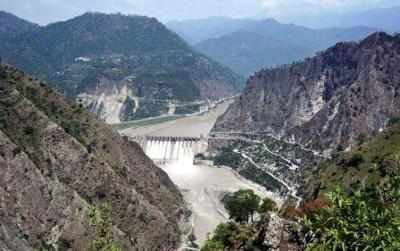HIGHLIGHTS
- Execution of Sawalkot project is expected to start early next year
- The Sawalkot project envisages a 193-meter-high dam on Chenab for generating 1,856 MW
- The under-construction Pakal Dul project has already received an impetus after the government displayed an urgency to complete it on time
NEW DELHI: India has set in motion its ambitious plan to utilise its share of water from western tributaries of the Indus, a decision driven by India-Pakistan geopolitics, which may see work begin on a major hydel project on the Chenab early next year. It is a long haul to implement PM Narendra Modi's September 27 decision to review water use within the ambit of the Indus Water Treaty (IWT) with Pakistan, but the government has prioritised three hydel projects on Chenab and its tributary —Sawalkot (1,856 MW), Pakal Dul (1,000 MW) and Bursar (800 MW) —in a time-bound manner.
Building infrastructure on Indus, Chenab, Jhelum and their tributaries is a huge task but the short-listed projects are intended to express India's political will and preparedness to respond to Pakistan's use of terrorism against India with every option at its command including a new preparedness to use all possible leverage points.
"The Centre has constantly been in touch with Jammu & Kashmir government for all necessary ground work. Execution of Sawalkot project is expected to start early next year. The under-construction Pakal Dul project has already received an impetus after the government displayed an urgency to complete it on time," said an official.
The Sawalkot project envisages a 193-meter-high dam on Chenab for generating 1,856 MW. It will be constructed in two phases. Since 629 families consisting of 4,400 individuals are likely to be displaced, the state government has been working on a proper rehabilitation plan before actual work begins. The Bursar project will, however, take time before it gets clearances.
"Since NHPC had initially termed it an unviable project on certain grounds, there is need for proper study before the government goes ahead with it. The project may be tweaked to make it viable as it is now our priority area," said the official. As previous cost and viability calculations are revised in view of the political imperative, India could be looking to use as much of Indus water as it can. "Maximising use of water must be priority. It is good that the government has sincerely moved to execute pending projects to legitimately use its share of water within IWT. This is the most realistic option well within the framework of the treaty," said Uttam Sinha of the Institute of Defence Studies and Analyses (IDSA).
Source: http://timesofindia.indiatimes.com/india/India-plans-to-make-most-of-its-share-of-water-under-Indus-pact-with-Pakistan/articleshow/55918158.cms








